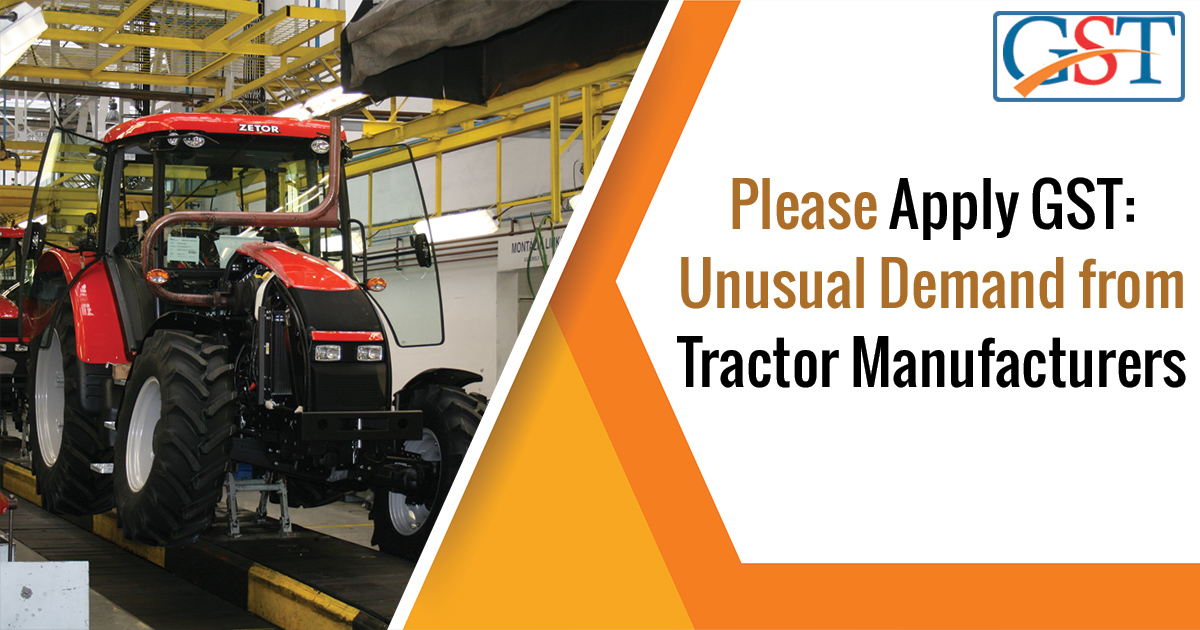In a market where industries are trying every bit to get some exemptions in tax rates, the tractor industry comes with the astonishing demand to levy tax over the sector. It is weird as well as logical in the light of the fact that after not getting chargeable to the excise on the output which will ultimately hold back the manufacturers from claiming any credit for the taxes and duties paid on the input.
Currently, the tractor industry is shelling out Cenvat (Central VAT or value added tax) rate of 12.5 percent on most of the parts and integral components including engine, gearbox, drive shaft, differential unit, wheels/tyres, fuel injection pump, electricals, seats, castings, forgings, sheet metal fabrication, etc. Given that, the tax duties can not be written off on these items which are charged separately.
But tractor as a whole product does not attract any excise duty which creates the uncommon demands from the sector dues to the aforementioned reason. Industrial sources mentioned that “GST should technically allow for tax on output to be set off against duties/taxes paid on inputs. But we dread a situation where the tax incidence on our inputs may further go up — because of the standard revenue-neutral GST rate (for the Centre and states combined) being fixed at, say, 18 percent — and the exemption for tractors would still remain.”
Read Also: Goods and Services Tax Impact on India Agriculture Sector
Since the year 2004-05, the tractors are fully exempted from the excise duties which were earlier taxed at 16 percent in the Union Budget of the first United Progressive Alliance (UPA) government. An official source from the ministry said that “We never sought it then. And now, we are all the more desperate that it goes.”
But here is the catch, farmers are overly paying even if there is no excise duty levied on the tractors but the manufacturers do this job as to fulfil the money sources which is denied from the route of input tax credit. As the components parts, capital equipment and services employed in tractor-making are the sources of revenue for the manufacturers as they are levied with taxes taken back from the farmer’s itself.
The overall tax assumptions on domestically manufactured tractors comes out to be 13.75 percent of the pre-tax price, as per industry calculations including the 5-5.5 per cent VAT currently levied on tractor sales by most of the states, while an added two per cent Central Sales Tax or CST on inter-state purchase (roughly 70 percent of inputs are procured locally and the remaining from outside the state of manufacture/final assembly), and the remaining 12.5 per cent Cenvat on components and parts. If the tax on other non-creditable service inputs, gets added to the overall taxation it would go around 13.85 per cent further commenting rationally.
The sources mentioned that “Thus if a farmer is paying Rs 6 lakh for a standard 40-horsepower tractor, over Rs 73,000 constitutes duties and taxes.” So in the direction the industry as given in writing to the government that even if the 12 percent tax duty is levied on the tractors, the final price will not be surging for the farmers. The sources also added that “If the cumulative input duties and taxes, which we now incur and pass on, can be set off, why should we raise end-user prices at all? The people in the government appreciate our logic, but we’re not sure whether that will lead them to bring back duty on tractors. Politically, it’s a decision not easy to sell.”
A relevant option emerges that a GST rate of 5 percent can be fitted over the tractors which also equal to the VAT applied currently by the states. But this seems not adjusting as it will only do away with the partial write-off from the duties and taxes on the inputs which can even attract a higher 18 percent GST slab rate. All this is going in the middle of Srinagar meeting ongoing from 18 to 19 May having all the chief officers and union finance minister Arun Jaitley himself.
Recommended: GST Refund Procedure Under Goods and Services Tax India
Coming to the second option is that make a zero duty on the tractors as the manufacturers are able to claim the full refund of duties and taxes paid on the inputs. But in the industry, the zero rating idea is least desired as still there is no answer to the input tax credit availability as in the provisions it states that the exempted goods can not be subjected to the input tax credit even if the end products are not taxed.
Here the source comes for an explanation that, “Claiming refund from the government would mean waiting for a minimum of six months, besides endless paperwork towards submitting claims. In the meantime, there will be huge liquidity and working capital pressures, as zero-rating also mandates us to immediately reduce prices in line with the GST’s anti-profiteering provisions. The industry wants neither zero-rating nor exemption. A 12 per cent GST on tractors, which will allow set-offs against input taxes through the normal process, is all that we desire.”
It was during the UPA rule that it saw a domestics sales growth from under two lakh to 6.3 lakh units ranging from years 2004-05 to 2013-14. TR Kesavan, president and chief operating officer of the Chennai-based Tractors and Farm Equipment Limited which is also the second largest tractor manufacturer after the Mahindra & Mahindra says that, “Last year, sales were flat in the South, where it didn’t rain much, and also partly impacted by demonetization. But North, West and Central India registered a rebound on the back of a good monsoon and bumper crop production. This year should hopefully be better. If the Met Department’s prediction of a normal monsoon comes right, we could look forward to record sales.”
